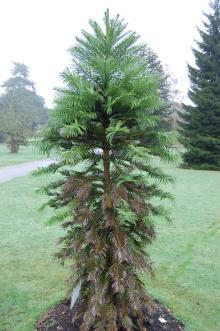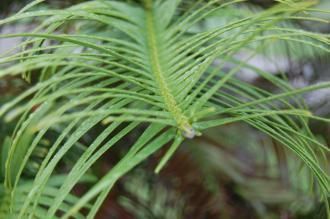
Wollemia nobilis (06/01/2013, Kew Gardens, London)
Position: Full sun to full shade
Flowering period: Spring
Soil: Moist, well drained
Eventual Height: 40m
Eventual Spread: 10m
Hardiness: 8a – 13
Family: Araucariaceae
Wollemia nobilis is an evergreen upright tree with a slender crown. Its yellow/ green leathery leaves are linear with entire margins, up to 8cm long and 5mm broad. Its trunk may achieve a diameter of up to 1m. Its dark brown bark is knobbly. Its monoecious green flowers are pollen cones, wind pollinated, up to 12cm long x 10cm broad (female) or 11cm long x 2cm broad (male) and appear at the end of branches. Its brown fruit is a cone, when the cone matures the branch dies.
Wollemia nobilis, commonly known as the Wollemi Pine, is native to Wollemi National Park in New South Wales, Australia. It was only know as a fossil until it was recently discovered in 1994. Wollemia nobilis is the sole member of the genus. In its native habitat it grows in deep sandstone gorges in temperate rainforest vegetation. It is classified as Critically Endangered according to the IUCN Red List of Threatened Species. The total population of mature individuals in the wild number approximately 80.
The etymological root of the binomial name Wollemia is named after the Wollemi National Park, where this tree was discovered. Nobilis is named after the discover of this tree David Noble, a field office of the Wollemi National Park.
The landscape architect may find Wollemia nobilis useful as an interesting specimen tree. This tree is not widely available at present although a propagation programme is under way.
Ecologically, Wollemia nobilis is of little wild life value in the UK.

Wollemia nobilis Leaf (06/01/2013, Kew Gardens, London)
Wollemia nobilis prefers moist, fertile, well-drained soils. It tolerates most pH of soil. This tree dislikes waterlogged soils.
Wollemia nobilis requires little maintenance. This tree copices readily.

